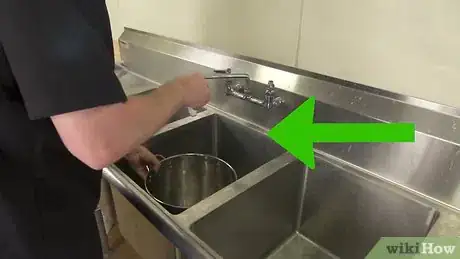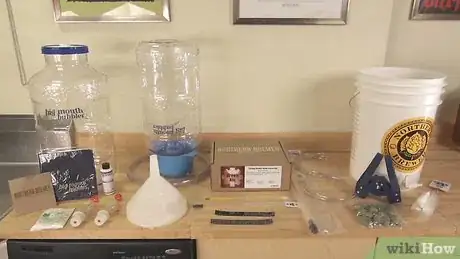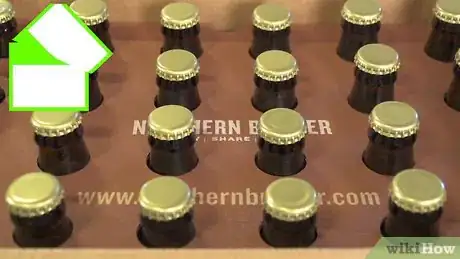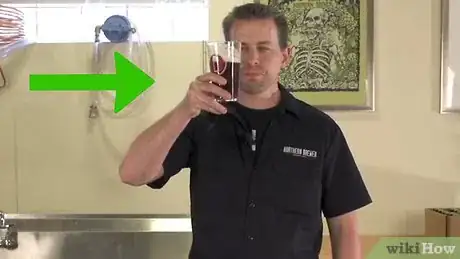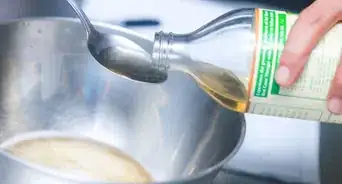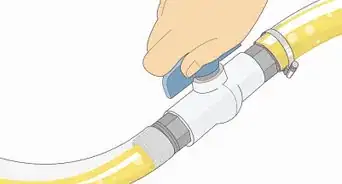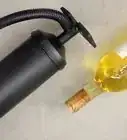wikiHow is a “wiki,” similar to Wikipedia, which means that many of our articles are co-written by multiple authors. To create this article, 68 people, some anonymous, worked to edit and improve it over time.
There are 15 references cited in this article, which can be found at the bottom of the page.
wikiHow marks an article as reader-approved once it receives enough positive feedback. In this case, 96% of readers who voted found the article helpful, earning it our reader-approved status.
This article has been viewed 1,339,598 times.
Learn more...
Brewing your own beer at home is easy, inexpensive, fun, and will most likely produce a brew far superior to that watery canned stuff. You'll also become like Bacchus to your beer buddies! We'll lay out the basic steps to get started, and show you how you can grow your skills and expand the varieties of beer you produce.
Ingredients
- Malt extract (liquid or dried)
- Hops
- Specialty grains
- Yeast (varieties all depend on the type of beer you are brewing, and these ingredients are all available in kits)
Steps
Preparation
-
1Keep it clean. As any experienced brewer will tell you, 80% of the secret of success is cleanliness. Thoroughly clean and sanitize everything that is going to come in contact with your beer. The easiest way to do that is to use an electric dishwasher set at the high heat setting or use a powdered cleanser such as PBW (Powdered Brewery Wash).
- Do not use a scrubber that will scratch the surface of whatever you're scrubbing—pathogens love to grow in the grooves left behind, and they're almost impossible to sanitize. Rinse well, then soak briefly in a bleach or iodine solution.
-
2Rinse everything well. Rinse off bleach before using items using very clean potable or distilled water. Do not assume tap water is sanitized for rinsing brewing equipment.[1]
- If you're using bleach to sanitize, add one ounce (30ml) of bleach to five gallons (19 liters) of cold water, followed by one ounce (30ml) of white vinegar. Do not mix the bleach and vinegar together before adding to the water! The vinegar will make the water more acidic, which helps the bleach sanitize.
- Do not rinse iodine solutions, let equipment drip dry instead.
- Note that bleach can cause unwanted flavours in your beer, and requires rinsing, which can introduce microorganisms to your sterilized equipment. If you want to sterilize your equipment properly, use either a food-grade cleanser or sanitizer such as One Step No-Rinse Sanitizer, which requires no rinsing; or an iodine solution such as BTF Iodophor.
- Remember, in beer brewing, you can do just about anything you want, and add anything you want, to make whatever kind of beer you want—but proper sanitizing is the MOST important thing you can do. Take the time and the energy to do it right.
Advertisement -
3Prepare everything before you begin. That includes cleaning and sanitizing as outlined, and also includes having all your ingredients prepared and measured in advance.
Brewing
-
1Take notes. Before you begin your foray into home brewing, get a notebook, and note down everything you do—the cleaning process, what strain of yeast, the amount and specific type of malt, what variety of hops, and any specialty grains or other ingredients used to produce your beer.
- This will allow you to reproduce any given brew, or provide a basis for experimentation and improvement.
-
2Steep your grains.[2] Put any specialty grains into a grain bag (a mesh bag to contain the grains—like a tea bag, only a lot bigger) and steep them in the large stock pot in three gallons (10 liters) of hot water (around 150°F (66°C) for about 30 minutes.
- Remove the grains and allow the water to drip out of the grain bag, into the pot. Do not squeeze the bag, because you may extract tannins that will give your beer an astringent flavor.
-
3Add the malt extract and bring everything to a boil. The hops are usually added at various intervals to add flavor, bitterness, or aroma and the times will be spelled out for you in the kit's instructions for your style of beer.
- In general, hops added early in the boil will contribute more bitterness, but at the expense of flavor and aroma. Hops added at the end of the boil will have a more pronounced flavor and aroma, but will not contribute significantly to the bitterness of the beer.
- Consider dry hopping your beer if you are looking for a brighter and less bitter flavor.[3]
-
4Chill your wort.[4] After you have boiled the liquid (called wort—pronounced wərt), you need to cool it as quickly as possible. The easiest way is to put the whole pot in a sink or bathtub that is filled with ice water.[5]
- You can gently stir the wort to help expedite the cooling, but try not to splash or aerate the wort while it's still hot (it can make for some funky flavors).
- Once it's around 80°F (27°C) you are ready to transfer it to the fermenter.
-
5Pour the cooled wort into your fermenter. After the wort has cooled and before fermentation starts is the one and only time that splashing is encouraged. Yeast need oxygen, and splashing the wort as you pour it into the fermenter will deliver that.[6]
- Once fermentation has started, you want to minimize exposure to air, as it will lead to off flavors and aromas.
- Using a large strainer (usually cheapest at restaurant supply stores), scoop the hops out—you've already got all the good stuff out of them. (If using a carboy, strain the wort as you pour it into the carboy).
- Add water to make five gallons (20 liters). You are now ready to "pitch" (add) the yeast. Some yeast requires that you "bloom" (stir with warm water to activate) them prior to pitching, others do not. You may find that even those that don't require blooming will start working faster if you do bloom them first, but it's usually no big deal.
- Put the lid on your fermenter (or stopper in your glass carboy) and affix the air-lock to the top. Put the fermenter in a dark area that stays a fairly consistent room temperature (for ales...lagers need refrigeration to ferment properly). In about 24 hours, you should notice the air-lock happily bubbling away, if it hasn't started doing anything after 48 hours, you might have a problem such as dead yeast.
Bottling
-
1Prepare for bottling! After a week or so, the activity from the airlock will slow to a crawl.[7] Leave it alone for two weeks measured from the time you first started the brewing/fermenting. The beer is now ready for bottling. Your kit probably came with some priming sugar or DME(dried malt extract).[8] This is used to provide carbonation to your beer once it is in the bottle.
- Boil the sugar in a little water and cool it. Then, add it to the empty, cleaned and sanitized bucket with the spigot or to your fermented beer.[9]
-
2Transfer the brew. Use your cleaned and sanitized plastic tubing as a siphon to transfer the beer as gently as possible—so that there's little or no aeration—from the fermenter to the bottling bucket with the priming sugar solution in it. Try not to get any of the sediment (trub) from the fermenter into the bottling bucket.
- Attach your cleaned and sanitized bottle filler to your clean and sanitized plastic tubing, the other end of the tubing attaches to the bottom end of the spigot. (If you are only using one bucket, it is important to let the fermented beer settle after stirring in the priming sugar solution. There is sediment on the bottom (trub) that will lend an off flavor to your beer).
-
3Get your thoroughly cleaned and sanitized bottles ready. If you are using a bottling bucket, just open the spigot and put the bottle filler in a bottle. Push the bottle filler to the bottom and that will let the beer flow.
- If using the one bucket method, fill the tube (attached to the bottle filler) with water and put the open end in the fermented beer and place the bottle filler in a glass, or a bottle or the sink, press down to let the water flow out and start the beer flowing in the tube like a siphon. Fill each bottle just to overflowing, then remove the bottle filler: this leaves an almost perfect airspace at the top of the bottle. Cap the bottle with your handy bottle capper, and repeat until all the bottles are full.
-
4Age the brew—briefly! Store the bottles for at least a week preferably two at about room temperature, then refrigerate.
-
5Get thirsty. When you're ready, open a bottle, and pour carefully into a glass. Leave about a quarter inch in the bottle—the sediment tastes a little yeasty, and will give you serious beer farts.[10]
-
6Enjoy!
Community Q&A
-
QuestionWhere can I get beer bottles?
 Community AnswerSpecialty brewing shops will have both bottles and caps. The sealer shown is a fancy one, but simpler cheaper versions are also available. Typically the people operating specialty brewing shops will advise you sensibly!
Community AnswerSpecialty brewing shops will have both bottles and caps. The sealer shown is a fancy one, but simpler cheaper versions are also available. Typically the people operating specialty brewing shops will advise you sensibly! -
QuestionHow much stuff do I need? How much yeast, malt extract, and hops?
 Community AnswerIt depends on how much you are going to make. Look for recipes to determine how much you need.
Community AnswerIt depends on how much you are going to make. Look for recipes to determine how much you need. -
QuestionDo I have to dry my homemade malt once germinated or can I mash with moisture in it?
 Community AnswerYou need to dry it to stop the fermentation and make your finished product taste better.
Community AnswerYou need to dry it to stop the fermentation and make your finished product taste better.
Warnings
- Be careful when adding the sugar to your bottles for carbonation. If you add too much they can explode!⧼thumbs_response⧽
- When boiling the wort, watch for boil-overs. That malt extract is some squirrelly stuff when it starts boiling. Same goes for boiling the DME for priming.⧼thumbs_response⧽
- Do NOT use "Brewer's Yeast" as sold in health food stores, etc. This is dead yeast, and won't work!⧼thumbs_response⧽
- If you are using a glass carboy, never pour hot wort directly into it, it will break from the temperature difference.⧼thumbs_response⧽
- Before adding extract to the boiling water, turn off the heat. Stir it in well, but gently, before turning the heat back on. This helps to avoid scorching the extract, and minimizes the chance of boil-overs.⧼thumbs_response⧽
- Check your country's laws about brewing your own brew. A few American states require permits.⧼thumbs_response⧽
Things You'll Need
- Large stock pot that can hold 3 gallons (11.4l). Preferably with a lid.
- 5 to 6 gallon (20-23l) food grade plastic bucket with an air-tight lid (or glass carboy) A second bucket with a spigot at the bottom will be good too.
- Air lock (available from home brew shops)or you can use one from an aquarium store for about $20USD less
- At least 2 cases of 12oz (355ml) bottles (non-screw tops work best). 500 milliliters (16.9 fl oz) bottles can be used if you would like to drink by the pint (may only be available in plastic with screw tops).
- Bottle filler (plastic tube with a spring-loaded nozzle at one end that keeps the beer from pouring all over the place)
- About 5 feet (1.5m) of food grade plastic tubing that will fit your bottle filler (for transferring the beer from the bucket/carboy to your bottles)
- Bottle capper
- Caps
References
- ↑ http://howtobrew.com/book/section-1/brewing-preperations/sanitation/sanitizing-your-equipment
- ↑ https://byo.com/article/6-steps-for-steeping-grains/
- ↑ https://byo.com/article/dry-hopping-techniques/
- ↑ http://howtobrew.com/book/section-1/boiling-and-cooling/cooling-the-wort
- ↑ https://byo.com/article/wort-chilling-techniques/
- ↑ http://howtobrew.com/book/section-1/fermenting-your-first-beer/transferring-the-wort
- ↑ http://howtobrew.com/book/section-1/priming-and-bottling/when-to-bottle
- ↑ https://www.brewcabin.com/priming-sugar/
- ↑ https://www.thesimpledollar.com/a-walkthrough-and-cost-breakdown-of-brewing-your-own-beer/
About This Article
To brew your own beer, you’ll need a 6-gallon (23-liter) carboy, an airlock, a stopper, a 5-gallon (19-liter) pot, a grain steeping bag, a racking cane, a funnel, glass beer bottles, and a bottle capper. You’ll also need cracked grains, liquid brewing yeast, liquid malt extract, hops, extra spices for flavoring, and conditioning tablets. A beer brewing kit will come with everything you need to get started if you don’t want to buy your equipment and ingredients separately. Once you have everything, sanitize your equipment by soaking it in diluted bleach for 20 minutes. Sanitizing is important so your beer doesn’t get contaminated and pose a health hazard. Next, activate the liquid brewing yeast following the instructions on the bag. Fill the grain steeping bag with your cracked grains. The type of grains you use will depend on what kind of beer you’re making. Tie off the bag, heat 3 gallons (11 liters) of water in your 5-gallon pot to 160°F (70°C), and steep the bag in the water for 1 hour. Make sure the temperature of the water stays consistent. Now, lift the bag out of the water and pour 4 cups (1 liter) of hot water over it, letting the water drain into the pot. Bring the pot of water to a boil and toss out the grains. Then, add 5 pounds (2 ¼ kilograms) of liquid malt extract and ½ ounce (140 grams) of hops to the pot. Let everything boil for 1 hour. Twenty minutes in, tie your extra spices, like coriander, cardamom, and ginseng, in a piece of cheesecloth and drop them into the pot of water. After the full hour, let the liquid in the pot, called “the wort,” cool to 80°F (35°), then funnel it into the carboy. Funnel filtered water into the carboy until you reach the 5-gallon (19-liter) mark. Next, funnel the activated liquid brewing yeast into the carboy and seal the carboy with your airlock and stopper. Place the carboy in a dark area away from sunlight and let it ferment for 14 days. After 14 days, add around 4 conditioning tablets to each glass beer bottle. Make sure the beer bottles and caps are sanitized. Then, use the racking cane to siphon the liquid beer into the bottles. Cap the bottles using your bottle capper, then place the bottles in a dark spot and let them sit for 3 weeks. Finally, transfer the beers to a fridge and let them cool for 24 hours before serving. To learn about how to bottle your beer, keep reading!
